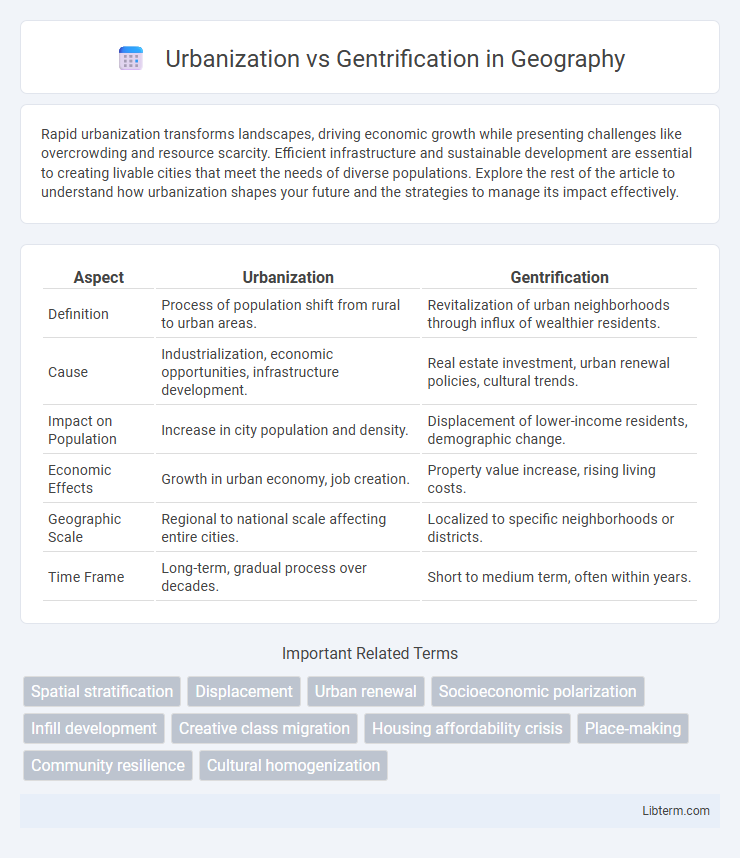Rapid urbanization transforms landscapes, driving economic growth while presenting challenges like overcrowding and resource scarcity. Efficient infrastructure and sustainable development are essential to creating livable cities that meet the needs of diverse populations. Explore the rest of the article to understand how urbanization shapes your future and the strategies to manage its impact effectively.
Table of Comparison
| Aspect | Urbanization | Gentrification |
|---|---|---|
| Definition | Process of population shift from rural to urban areas. | Revitalization of urban neighborhoods through influx of wealthier residents. |
| Cause | Industrialization, economic opportunities, infrastructure development. | Real estate investment, urban renewal policies, cultural trends. |
| Impact on Population | Increase in city population and density. | Displacement of lower-income residents, demographic change. |
| Economic Effects | Growth in urban economy, job creation. | Property value increase, rising living costs. |
| Geographic Scale | Regional to national scale affecting entire cities. | Localized to specific neighborhoods or districts. |
| Time Frame | Long-term, gradual process over decades. | Short to medium term, often within years. |
Understanding Urbanization: Definition and Key Features
Urbanization refers to the increasing population concentration in cities and towns, driven by rural-to-urban migration and economic development. Key features include expansion of urban infrastructure, increased demand for housing, and transformation of social and economic activities to urban-centric models. This process fosters diverse labor markets and cultural dynamics, essential for sustained metropolitan growth.
What is Gentrification? Unpacking the Concept
Gentrification refers to the process where urban neighborhoods experience an influx of more affluent residents, often leading to increased property values and displacement of lower-income families. This transformation typically involves renovations, new businesses, and cultural shifts that change the social fabric of the community. Unlike general urbanization, gentrification specifically highlights socio-economic changes driven by real estate dynamics and investment patterns.
Historical Context: The Evolution of Urban Spaces
Urbanization refers to the population shift from rural to urban areas, driving the expansion of cities and infrastructure since the Industrial Revolution. Gentrification, emerging prominently in the late 20th century, involves the transformation of historically working-class neighborhoods through investment and influx of more affluent residents. These processes have reshaped urban spaces by altering demographics, socioeconomic structures, and cultural identities over time.
Drivers Behind Urbanization and Gentrification
Rapid population growth and economic development serve as primary drivers behind urbanization, attracting individuals to cities seeking employment and improved living standards. Gentrification, often propelled by investment in real estate, infrastructure upgrades, and changing socio-economic dynamics, transforms urban neighborhoods, increasing property values and displacing lower-income residents. The interplay between these forces reshapes urban landscapes, influencing housing affordability, demographic shifts, and community composition.
Economic Impacts: Job Growth vs. Displacement
Urbanization drives economic growth by attracting businesses and creating diverse job opportunities in expanding cities. Gentrification often leads to displacement of lower-income residents as rising property values and living costs push them out, despite potential short-term economic gains. The tension between job growth and displacement highlights challenges in equitable urban economic development.
Social Consequences: Community Building or Fragmentation?
Urbanization often fosters community building by increasing diversity and creating economic opportunities, yet it can also strain infrastructure and social services, leading to fragmentation. Gentrification tends to displace long-term residents, eroding established social networks and cultural identity, which results in community fragmentation. Both processes reshape urban landscapes but have contrasting impacts on social cohesion and neighborhood dynamics.
Urban Planning: Policies Shaping City Transformation
Urban planning policies significantly influence urbanization by guiding infrastructure development, zoning laws, and public transportation expansion to accommodate growing populations sustainably. Gentrification emerges as a result of these policies when redevelopment initiatives increase property values and attract higher-income residents, often displacing long-term, lower-income communities. Effective urban planning balances economic growth with social equity through inclusive housing policies, community engagement, and preservation of cultural heritage.
Housing Market Effects: Affordability and Accessibility
Urbanization drives demand for housing, increasing prices and reducing affordability in metropolitan areas. Gentrification accelerates this trend by attracting higher-income residents, displacing lower-income communities, and limiting accessible housing options. The combined effect strains the housing market, creating shortages of affordable units and intensifying socioeconomic divides in urban neighborhoods.
Case Studies: Comparing Global Urban Trends
Urbanization drives rapid city expansion, as seen in megacities like Lagos and Mumbai, where population growth fuels infrastructure development and housing demand. Gentrification reshapes neighborhoods, exemplified by Brooklyn in New York and Shoreditch in London, where new investments often displace low-income residents while boosting local economies. Comparing these global trends reveals contrasting impacts: urbanization pressures basic services, whereas gentrification transforms social fabric and property markets.
Navigating the Future: Sustainable Urban Development Solutions
Sustainable urban development solutions address the challenges posed by urbanization and gentrification by integrating green infrastructure, affordable housing, and inclusive zoning policies to balance growth with community preservation. Implementing smart city technologies enhances resource efficiency while supporting equitable economic opportunities to prevent displacement. Collaborative governance involving stakeholders ensures adaptive planning that prioritizes environmental resilience and social equity in rapidly changing urban landscapes.
Urbanization Infographic

 libterm.com
libterm.com